If you try to imagine schools back in the 1920s, the first thing that might come to mind might be a single room class with a chalkboard in the front and wooden desks and chairs stretching towards the back. You might even picture the whole image in black and white with students donned in uniform neatly lined up in the classroom rows. This type of public school system looks nothing compared to the one we enjoy today. Contemporary public schools in America diverge from the curriculum instilled in public school systems in the 1920s, yet both still reflect the societal culture and promote patriotism.
In the 1920s, public schools had completely different curriculums than current schooling systems. In that era, progressive movements and figures like John Dewey pushed for student-led classes. Dewey and other reformers advocated more vocational based education, focusing on certain trades and crafts. The school systems in that time period called for a more job and trade-oriented curriculum because of the societal demands for an able and educated workforce. On the other hand, schools now have curriculums based on the national academic subject groups in each state or the Common Core as dictated by the Department of Education. Teachers now lead the classroom based on these curriculum guidelines, requirements and tests.
Liberal educational standards are more commonly used, focusing on teaching "a broad array of intellectual and practical abilities" for all students regardless of their different fields of study. The objective for the modern curriculum as opposed to vocational academia is to focus more on graduation and general education unspecific to certain jobs and trade, rather than developing a specific skill set for a certain trade. Both schools in the early 1920s and present-day reflect their respective societal culture.
Public schools in the 1920s, given the religious atmosphere, were hesitant in teaching evolution to students, which resulted in the Scopes Monkey Trial of 1925. The newly-passed Tennessee law prohibited any evolutionary study or teaching that went against the Bible. The society's reverence for biblically oriented classrooms allowed for the state of Tennessee to keep its law. Furthermore, academics were often divided along gender lines. Girls' education was geared toward classes that would help them run a household because it was socially encouraged for women to be homemakers.
School systems in the present day also reflect gender norms, but in light of the social movements regarding gender rights, they are promoting equality. Organizations such as theGirl Scouts of the USA provide girls the opportunity to engage in challenging topics such as STEAM, in hopes of interesting them in a variety of fields. Social movements and gender norms translated into education either at a federal level or a curricular level.
Not to mention, patriotism has been a reoccurring theme in schools in the 1920s and the present day. Patriotic classroom practices and politics almost always reflected a tense political-social atmosphere. The post-World War I mindset, composed of a nationalist surge from returning soldiers as well as hatred for communism, contributed to a redefined school system. As a result, sometimes "teachers had to sign oaths stating that they were loyal Americans and not communists".
This same concern for the United States and its betterment can be seen in the current school systems. Due to school shootings, for instance, students are fighting for changes in political policy out of patriotism for their country. Unfortunately, many biased practices in the name of promoting patriotism reoccur in schools, both now and then. For example, history books have consistently stayed biased, oftentimes overlooking the horrors that America has inflicted on minorities. As a result, many students learn a patronizing version of American history that portrays the nation in light and glory.
The pledge of allegiance, in the 1920s, symbolized a certain reverence for the country in both a nationalistic and patriotic manner. For some people in the present day, however, kneeling or sitting for the pledge, in the footsteps of Colin Kaepernick is another form of patriotism.
Public education has changed drastically especially from the 1920s to now. One of the many changes between public schools now and then has been the curriculum, in particular, vocational and general academic education. However, the social and political atmosphere and its effects on public schools in both time periods seem to have been eminent and reoccurring. The promotion of patriotism through historical biases as well as political and social tension was common in both the early 1920s as well as now. Despite the difference between public education in America now and in the early twentieth century one thing is for certain: as society grew and became more diverse so did public education. Nonetheless, the core values of public education have stayed the same

















